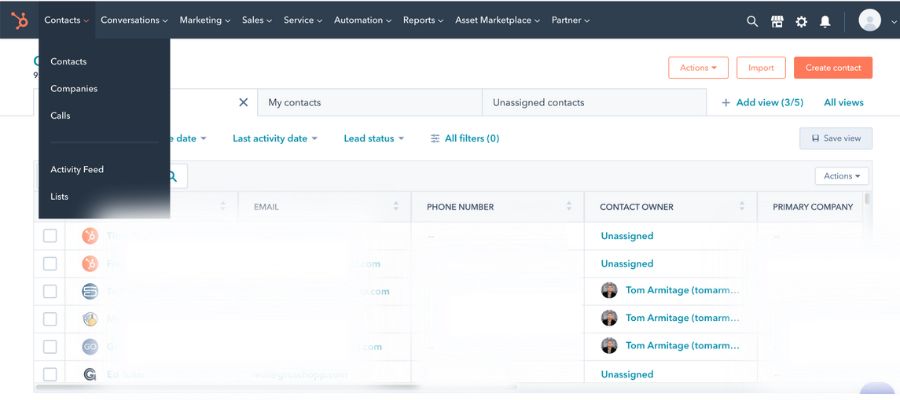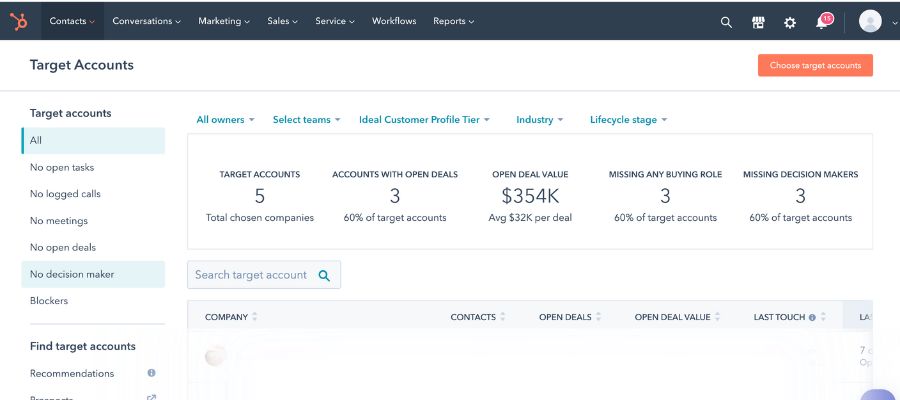RESOURCES | BLOG
What Is ABM? And How to Develop An Account-Based Marketing Strategy
Marketing has often been typecast as being a “spray and pray” type of investment.
But wouldn’t it be better (and more efficient!) if you could target and sell directly to your most qualified accounts?
Well, today, you can.
This is what Account-Based Marketing (ABM) helps you do. From the early stages of your strategy, ABM lets you eliminate unqualified companies to help you improve the efficiency of your efforts, boost the response rates from your buyers, and, ultimately, increase the ROI of your campaigns.
Do you notice that when you send out personalized emails to your contacts, those perform much better than mass sends? That’s because you’re sending customized communication to the right audience.
It isn’t surprising that the right ABM strategy can uplift marketing revenue by 208%. According to a SiriusDecisions report, 92% of B2B businesses said, “ABM is an extremely important part of their overall marketing efforts.”
In this article, we’ll review some of the tools that can support your ABM efforts and what steps you can take to start developing your strategy today!
But first…
What is Account-Based Marketing?
ABM, also called key account marketing, is a strategic approach that focuses on 1:1 marketing rather than 1-to-many. As Marketo puts it, ABM leverages “the combined expertise of the marketing and sales teams to target select groups of accounts that require tailored [messaging].”
Considering that capturing the attention of prospective customers is becoming harder and harder, ABM can become a great ally in fighting this resistance issue and helping your company attract the accounts your business leaders crave.
Your current efforts are probably casting a wide net and trying to appeal to as many organizations as possible. With ABM, we need to do the opposite and flip the typical sales funnel on its head by targeting only the accounts you want with hyper-personalized communications.
But how do you decide what businesses you should focus on?
ABM Tools For Success
ABM Pyramid
The first thing you should do is to develop criteria to determine what companies you’d like to target. In other words, what is your ICP (ideal customer profile)?
Personally, I’m a big fan of the ABM Pyramid to segment your accounts.
The top of the pyramid represents one-to-one engagement, and it’s where the main businesses that you want to focus on are. The middle refers to a one-to-few model, while the bottom represents one-to-many.
Take time to sit down with your marketing and sales teams to align efforts, expectations, and goals – and select your key accounts to target.
Tier #1
The top tier, often called Strategic ABM, is resource-intensive.
Your teams will have to decide on a bunch of key accounts that have unique needs and create marketing plans to attract or enhance the relationship with these companies.
It’s also important to come up with the efforts necessary to conduct research to develop relevant hyper-targeted messaging. We recommend creating individual personas within each of these accounts to better understand their behavior, interests, and needs.
It’s possible your accounts may have multiple persons at each company – whether decision-makers, influencers, or a combination of both – that will impact their relationship with you.
Tier #2
The one-to-few model of the middle tier requires less intensive focus and resources.
Marketing and sales will collaborate to identify 10-50 companies that have similar businesses, challenges, and needs.
Tier 2, usually referred to as ABM Lite, still requires a good understanding of the chosen accounts in order to be effective.
It’s important to choose a few business issues and pain points to address and frame your messaging accordingly.
Tier #3
The bottom tier is called Programmatic ABM and follows a one-to-many model. Here your teams can group hundreds of companies and segment them by industry, geographic region, or in any collective way.
Even though you will not be able to create hyper-personalized content for hundreds of companies at once, it can still be helpful to follow a customer-centric approach in your communications.
I’ll give you an example.
Think about each industry you serve – let’s say it’s automotive, HVAC and aerospace – and develop messaging that addresses the pain points of each. Build your campaigns for each Tier 3 group based on their industry.
Let’s look at two tools in particular that can help you immensely with your ABM efforts.
Hubspot
Hubspot is the #1 automation software in the world, offering marketing, sales, operations, service, and web management tools.

It’s a powerful software loved by so many B2B marketers.
But hey… don’t take my word for it. There are over 150,000 businesses across 120+ countries that use HubSpot, and this includes many of our clients at Site-Seeker.
The all-in-one platform allows users to connect all data – from sales to marketing to customer service – while using personalization and automation.
If you have a Professional Enterprise plan, Hubspot offers well-rounded features that can help you implement your ABM program. Let me give you a small taste of what Hubspot offers to support your efforts. It’s time to brace yourself!
- Import or create target accounts directly in Hubspot.
- Track account activity on the Target Accounts page to view interactions, deals, and tasks, ensuring both sales and marketing teams are on the same page on the state of each account.

- Use AB testing and dynamic content to offer a personalized experience for visitors
- Leverage lead scoring to push ready-to-buy accounts to sales once they hit a certain threshold.
- Use automated workflows to segment lists, automate processes and internal and external communications, update properties, assign tasks, and more.
- Update the lead status and lifecycle stage of your contacts based on their behavior or buying intent
- Seamlessly integrate Hubspot with third-party tools, such as Google Ads, ZoomInfo, Slack, and LinkedIn Sales Navigator, to add more efficiency throughout your organization
- Use offline gifting integrations to automatically send postcards or gifts to your top-tier accounts.
This is just part of what Hubspot can offer – it’s worth considering it, right?
ZoomInfo
ZoomInfo is another great deal and can complement both Hubspot and your ABM efforts quite well.
ZoomInfo is a B2B lead intelligence software. (It may sound familiar, as we’ve already mentioned it in our article “How Lead Intelligence Can Maximize Sales & Marketing Efforts.”)
Once you’ve come up with your criteria and have identified your ICPs, it’s time to lean into ZoomInfo and its rich contact database.
The software can help you in several ways.
- First, some of your ideal customers may be within your existing database. In this case, when integrated with Hubspot, the tool can help you enrich the contacts and company data you’re already storing so that you can reach them with the most appropriate and accurate info.
- Now, let’s say that you can not locate target accounts within your database. ZoomInfo can help you identify high-fit prospects by filtering companies using specific criteria such as industry, location, employee count, NAICS codes, technology used, and more.
Once you have found the companies that match your ICP, you can export them and import them into your database. Your sales team can then develop an outreach strategy and make contact with the most compelling messaging. - Third, you can use ZoomInfo by leveraging its buyer intent data. Intent data is a type of sales intelligence that shows the accounts that are likely researching or considering a particular solution.
In other words, you could identify who might be ready to buy your product in the next 30 days, gather their contact info, and reach out to the decision-makers.
Ultimately, this will help you prioritize your efforts to engage ready-to-buy prospects and have a greater impact with your time.
How Can I Start My ABM Strategy Today?
As you’ve probably realized already, ABM takes a lot of time and effort and is a big investment. All team members across both sales and marketing have to be aligned and on the same page. The roles and responsibilities have to be clear, and everyone should be aware of the tools that will be used.
If you’re ready to kick start your ABM strategy, these are the steps you can take:
- Assemble your account-based marketing team: Remember that both marketing and sales should be involved to ensure success!
- Define your goals: You need to know where you’re going if you want to be successful in marketing. Goals give you purpose, direction, and vision. They will be the foundation of the plan you build to get to your destination!
- Determine what tools you’ll use: You’ll need to consider many factors. Do you already have a CRM or a marketing automation tool? If not, are going to use Hubspot? Something else? Do you have access to a lead intelligence tool like ZoomInfo? What’s your budget to purchase tools like these?
- Choose your target accounts (and criteria!): The ABM pyramid we discussed above can help you segment the accounts according to your chosen criteria.
- Select channels and create tailored messaging: You need to know where your audience is and their preferences. How do they consume content? Where? When? Find out, be there, and tailor them with personalized content.
- Implement your strategy: Time to put everything together and execute your strategy. Ensure all team members are aware of where each account is in the buyer’s journey and keep delivering timely communications through your marketing campaigns. This should be at least a 12-month campaign or longer.
- Measure it and be ready to pivot: It’s important to measure the ROI for each account you’re investing your resources and time in. If something doesn’t work, don’t give up! Adjust your strategy accordingly and keep pushing forward.
Conclusion: Grow Your Business With Account-Based Marketing
People want to feel special. Make your target accounts feel the same way!
There are many options out there that can help you with your ABM strategy. The ones we discussed are some of the tools we use for our clients. It’s important to keep in mind that each company is unique, and there is no one-size-fits-all solution.
Even though it can be a bit overwhelming, make sure to do your research first to determine what could work best for you within your budget. If you need any help, don’t hesitate to reach out to our team.
What Is “Hooked On Marketing With Corinne And Carlotta?”
Hooked On Marketing With Corinne And Carlotta is a 4-episode video series about how to enhance your business’s digital presence through digital marketing.
This series aims to provide you with an in-depth understanding of 4 different marketing strategies and tools that are available today and how they can help your business grow its online presence. These include Search Engine Optimization, Google Ads, Lead Intelligence, and Account-Based Marketing.
Each episode covers tools for success, real-world applications, success stories, and actionable items you can start implementing today.
Hooked On Marketing is led by Carlotta Bartolini, Account Manager at Site-Seeker. They are accompanied by Coco, their monkey mascot.
